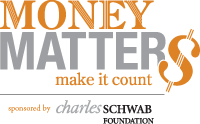How do you stack up where financial literacy is concerned? How do your children?
The FINRA Foundation’s 2012 State-by-State Financial Capability Survey revealed that:
- 41% of Americans surveyed reported spending less than their income.
- 26% reported having unpaid medical bills.
- 56% do not have rainy-day savings to cover three months of unanticipated financial emergencies.
- 34% reported paying only the minimum credit card payment during the past year.
These numbers aren’t good, but if I’m being completely honest with you I have to admit, though I do spend less than my income and have no unpaid medical bills (thanks to not having any significant medical expenses in the last several years) I definitely don’t have a rainy-day savings fund that could cover even one month of unanticipated financial emergencies.
In an article in USA Today, Hadley Malcolm reported about a young woman who had in the past few years “‘just scraped together,’ which she attributes to an unstable income and sporadic spending habits.” Malcolm continued to write that “today’s twentysomethings hold an average debt of about $45,000, which includes everything from cars, to credit cards, to student loans, to mortgages…”
At what point to people start to learn about financial literacy? For some, like Andrew Whiting—whose story Malcolm relates—it began in elementary school as his father, a certified financial planner, began teaching him about earning money, saving, and making financially responsible choices. At age fifteen Andrew got his first job and once he had a driver’s license he bought the family car from his parents. These financial skills, which he learned in childhood and adolescence, have had a shaping influence for him. “I’m more wary about my finances than a lot of people, I realize,” Andrew says.
Not everyone is fortunate enough to have this background. Malcolm quoted a college senior, Paulo Fernandes, who says, “I just kind of do what I have to do.” Fernandes reportedly had to teach himself how to manage finances, student loans, and his credit card. His older siblings and mother didn’t go to college, and he didn’t feel that he could rely on any of them to help him.
“If we live in a world where people are in charge of their own financial well-being…we have to equip people to deal with this individual responsibility. It’s an issue of equality. Not everybody is given an opportunity at home to be financially literate. This is a topic that should be in the schools.” – Annamaria Lusardi, professor of economics and accountancy and director of the financial literacy center at George Washington University.
Utah is one of only 17 states that “require[s] high school students to take courses that include personal finance instruction,” and one of only four states that “require[s] that high school students take a stand-alone personal finance course to graduate,” according to a March 2014 report by the PEW Charitable Trusts. Still, this high school course is only
At the Boys & Girls Clubs of Utah County, we set out to serve all young people, especially those most in need of our help. One of the programs run nationally through the Boys & Girls Clubs of America is Money Matters, sponsored by the Charles Schwab Foundation.
Money Matters promotes financial responsibility and independence among Club members ages 13 to 18. Participants learn how to manage a checking account, create a budget, save and invest, start small businesses, and pay for college. The curriculum utilizes small-group activities, personal finance guides, and a website that provides games and tools that help teens build their own money management skills.
This program works. Recently, 1,600 teens from more than 100 Boys & Girls Clubs were surveyed before and after participating in the Money Matters program. These youth showed improvement on 94% of survey questions. Some of the improvements include:
- Saving Smarts—Understands the 10% savings rule
- Before: 47%
- After: 71%
- Budgeting Know-How—Puts needs before wants
- Before: 67%
- After: 78%
- Debt Savviness—Knows that using a credit card creates debt
- Before: 50%
- After: 71%
- Behavior Change—Saves Instead of spends
- Before: 68%
- After: 79%
Programs like this make a difference for the Club members involved. When we say that “Great Futures Start Here,” it’s not just a cute slogan. For our club members, great futures really do start with their experience in the Boys & Girls Clubs. From lessons in personal finance and financial literacy, to homework help, to STEM activities, arts programs, and more, the experiences provided through the Boys & Girls Clubs lay the foundation for these club members to explore and pursue new interests and opportunities.

